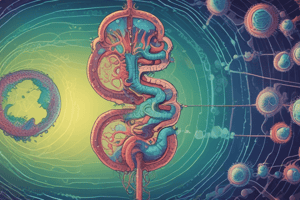Podcast
Questions and Answers
What is the primary importance of macroscopic description of CSF samples?
What is the primary importance of macroscopic description of CSF samples?
- To determine the biochemistry of the sample
- To detect blood staining in the tubes
- To identify the patient's name on the tubes
- To record exactly what is received and where it goes (correct)
Why is it essential to inspect the tubes before processing?
Why is it essential to inspect the tubes before processing?
- To verify the patient's name on the tubes
- To check for blood staining in the tubes
- To ensure the tubes are properly labelled (correct)
- To determine the biochemistry of the sample
What is the purpose of loading two counting chambers in the biohazard cabinet?
What is the purpose of loading two counting chambers in the biohazard cabinet?
- To mix the samples from tubes 1 and 3
- To store the supernatant from tubes 1 and 3
- To prepare the tubes for centrifugation
- To perform cell counts on tubes 1 and 3 (correct)
What is the purpose of taking off the supernatant from tubes 1 and 3?
What is the purpose of taking off the supernatant from tubes 1 and 3?
What is the significance of the centrifugation step in the process?
What is the significance of the centrifugation step in the process?
What is the rationale behind taking the remainder from tube 1 to combine with tube 3?
What is the rationale behind taking the remainder from tube 1 to combine with tube 3?
What is the significance of xanthochromia in CSF?
What is the significance of xanthochromia in CSF?
Why is it important to perform cell counts on both tubes 1 and 3?
Why is it important to perform cell counts on both tubes 1 and 3?
What is the purpose of adding CSF to a tube coated with dry toluidine blue dye?
What is the purpose of adding CSF to a tube coated with dry toluidine blue dye?
What is the significance of a low sugar level in the CSF?
What is the significance of a low sugar level in the CSF?
What is the rationale for recording the macroscopic appearance of CSF?
What is the rationale for recording the macroscopic appearance of CSF?
Why is it important to protect the CSF sample from light during biochemical investigation of xanthochromia?
Why is it important to protect the CSF sample from light during biochemical investigation of xanthochromia?
Study Notes
Describing CSF Samples
- A macroscopic description of CSF is crucial and should include recording exactly what is received and where each tube goes.
- For a CSF requesting M, C & S, cytology, and biochemistry, record 3 tubes of 1 ml each, with Tube 2 sent to cytology, and cell count and supernatant sent to biochemistry.
Processing CSF Samples
- Inspect tubes for clarity and perform cell counts on tubes 1 and 3.
- Aseptically load 2 counting chambers, one for tube 1 and one for tube 3, and centrifuge the tubes.
- Take off the supernatant (around 90%) from tubes 1 and 3, combine the remainder, and send tube 1 supernatant to biochemistry and tube 2 (untouched) to cytology.
Macroscopic Appearance of CSF
- Record the volume of CSF received in each tube, turbidity, bloodstaining, and xanthochromia.
- Xanthochromia is a yellow-orange color of the supernatant, indicating a recent subarachnoid hemorrhage (SAH).
- A traumatic tap is when a capillary is hit during lumbar puncture, causing blood in the CSF, and can be differentiated from SAH by performing cell counts on both tubes 1 and 3.
Biochemistry and Cell Counts in Meningitis
- Biochemistry and cell counts can help identify the cause of meningitis, such as viral, bacterial, or fungal infections.
- Lymphocytes may indicate viral, tuberculous, or yeast infections, while polymorphs indicate life-threatening infections.
- CSF biochemistry can show low sugar levels, indicating bacterial or fungal consumption, and increased protein levels, indicating more severe inflammation.
Studying That Suits You
Use AI to generate personalized quizzes and flashcards to suit your learning preferences.
Description
Learn about the importance of accurately recording and handling CSF samples, including macroscopic description and distribution of samples for various laboratory tests.




